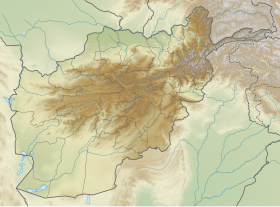Siege of Bamyan
| Siege of Bamyan | |||||||
|---|---|---|---|---|---|---|---|
| Part of the Mongol invasion of the Khwarazmian Empire | |||||||
| |||||||
| Belligerents | |||||||
| Mongol Empire | Khwarazmian Empire | ||||||
| Commanders and leaders | |||||||
| Genghis Khan Mutukan † | Jalal al-Din Mangburni | ||||||
| Strength | |||||||
| 30,000 | Unknown | ||||||
| Casualties and losses | |||||||
| Unknown | Very heavy | ||||||
Location of the siege on a map of modern Afghanistan | |||||||
The siege of Bamyan (Persian: محاصره بامیان) was a siege that took place in 1221, during the Mongol conquest of the Khwarazmian Empire. An army under the leadership of Genghis Khan, ruler of the Mongol Empire, who was in pursuit of Jalal al-Din Mangburni, the last ruler of the Khwarazmian Empire, besieged the citadel of Shahr-e-Gholghola near modern Bamiyan. The siege led to a devastating attack that left the city in ruins.[1]
Events
[edit]The siege occurred in 1221 while the Mongols were pursuing Jalal al-Din Mangburni, the last ruler of the Khwarazmian Empire, where Jalal al-Din Mangburni had formed a new Muslim army in Afghanistan.[2] During the siege, the Mongol army led by Genghis Khan besieged the city of Bamiyan.[3] The city possessed significant defensive fortifications. The Mongols continued their siege despite facing resistance. After considerable resistance the Mongols breached the walls and captured the city[4]. During the siege Mutukan, the son of Chagatai Khan and grandson of Genghis Khan, was killed in the battle by an arrow from the besieged city walls.[5] His death, coupled with the significant losses his army had suffered, is said to have prompted Genghis Khan to order the execution of the city’s inhabitants and the city’s destruction. The scale of destruction led to the city being referred as "the city of sorrows" and "the city of noise (or screams)".[6][7]
Following the siege Genghis Khan subsequently advanced in pursuit of Jalal ad-Din Mangburni.[8] After the local Afghan population was devastated the replacement Mongol settlers would eventually become the ancestors of the Hazara people.[9][10] Today the site of the ancient city of Bamiyan is a UNESCO World Heritage Site,[11] and the ruins of the citadel and the old city are still visible from modern day Bamiyan.[12][13]
References
[edit]- ^ "City of Screams: Gholghola". Visit Bamiyan. 4 June 2020. Retrieved 2025-02-04.
- ^ Kohn, George C (2007). Dictionary of Wars. New York : Facts on File/Checkmark Books. p. 55.
- ^ Kohn, George C (1986). Dictionary of Wars. New York, N.Y. : Facts on File. ISBN 0816010056. p. 48.
- ^ Morgan, Llewelyn (2012). The Buddhas of Bamiyan. Cambridge, Mass. : Harvard University Press. ISBN 9780674057883. p. 36.
- ^ Behnke, Alison (2008). The Conquests of Genghis Khan. Minneapolis : Twenty-First Century Books. ISBN 9780822575191. p. 106.
- ^ "Remembering Bamiyan". Kashgar.com.au. Archived from the original on 4 October 2013. Retrieved 9 October 2013.
- ^ Roux, Jean-Paul (2003). Genghis Khan and the Mongol Empire. New York : Harry N. Abrams. ISBN 0810991039. p. 124.
- ^ Behnke, Alison (2008). The Conquests of Genghis Khan. Minneapolis : Twenty-First Century Books. ISBN 9780822575191. p. 107.
- ^ Metcalfe, Daniel (2010). Out of Steppe. London : Arrow Books. ISBN 9780099524991. p. 168.
- ^ Mousavi, J. Sayed Askar (1998). The Hazaras of Afghanistan : an historical, cultural, economic and political study. Richmond, Surrey : Curzon. ISBN 0700706305. p. 147.
- ^ "Cultural Landscape and Archaeological Remains of the Bamiyan Valley". UNESCO World Heritage Centre. Archived from the original on 28 January 2007. Retrieved 2 August 2022.
- ^ "Shahr-e Gholghola in Bamiyan, Afghanistan". Lonely Planet. 2011-09-28. Retrieved 2012-05-09.
- ^ Romano, Amy (2003). A Historical Atlas of Afghanistan. New York : Rosen Pub. Group. ISBN 0823938638. p. 25.


